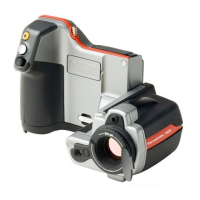27 Introduction to building
thermography
27.1 Important note
All camera functions and features that are described in this section may not be sup-
ported by your particular camera configuration.
27.2 Typical field investigations
27.2.1 Guidelines
As will be noted in subsequent sections there are a number of general guidelines the
user should take heed of when carrying out building thermography inspection. This
section gives a summary of these guidelines.
27.2.1.1 General guidelines
■ The emissivity of the majority of building materials fall between 0.85 and 0.95.
Setting the emissivity value in the camera to 0.90 can be regarded as a good
starting point.
■ An infrared inspection alone should never be used as a decision point for further
actions. Always verify suspicions and findings using other methods, such as con-
struction drawings, moisture meters, humidity & temperature datalogging, tracer
gas testing etc.
■ Change level and span to thermally tune the infrared image and reveal more details.
The figure below shows the difference between a thermally untuned and a thermally
tuned infrared image.
10552103;a2
Figure 27.1 LEFT: A thermally untuned infrared image; RIGHT: A thermally tuned infrared image, after
having changed level and span.
Publ. No. 1558792 Rev. a460 – ENGLISH (EN) – July 1, 2010 133

